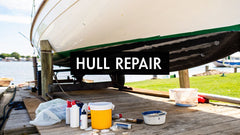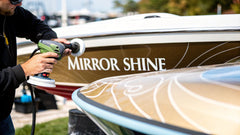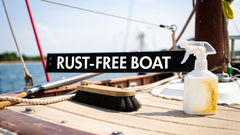Best Boat Vinyl Cleaner for a Pristine Finish
When you're hunting for the best boat vinyl cleaner, you’ll quickly find that names like Star brite's Vinyl Cleaner and Polish are at the top of almost every list. And for good reason. The right cleaner is so much more than a simple soap; it's your first line of defense in protecting your investment from the harsh marine environment.
Why Your Boat’s Vinyl Needs a Specialized Cleaner
The vinyl on your boat isn't the same stuff you'd find on a kitchen chair. It's a high-performance material specifically engineered to take a constant beating from sun, salt, and moisture. Your living room sofa doesn't have to deal with these unique challenges, which can quickly lead to cracked, faded, and ruined upholstery if you don't use the right products. Grabbing a random household cleaner can actually strip away its protective layers, accelerating the damage.
This is exactly where a specialized boat vinyl cleaner proves its worth. These formulas are built from the ground up to handle marine-specific issues without harming the vinyl's integrity.
- UV Ray Defense: They’re packed with inhibitors that block damaging ultraviolet rays—the number one culprit behind vinyl turning yellow, hard, and brittle over time.
- Mildew and Mold Prevention: Marine cleaners have ingredients that don't just scrub away existing mildew stains but also leave behind a barrier to stop new growth from taking hold in the damp conditions.
- Saltwater Resistance: They're formulated to break down and lift away the corrosive salt deposits that dry out and weaken both the vinyl and its stitching.
The need for these specific products is backed by the numbers. The marine vinyl market was valued at roughly $340 million in 2023 and is expected to climb to nearly $488 million by 2030. That growth is all about the material's incredible resistance to tearing, water, and UV damage—which just goes to show why specialized care is so important. You can find more details on the marine vinyl market at ResearchAndMarkets.com.
Take a look at the typical marine vinyl upholstery you’d find on any boat. It requires very specific care to stay looking its best.
Notice how the material is stitched and textured? Those are prime spots for dirt, grime, and mildew to settle in. Getting a handle on the basics of how to clean marine vinyl upholstery is your first step toward making it last for years.
Using the right cleaner isn’t just a cleaning chore—it’s preventative maintenance. A dedicated boat vinyl cleaner preserves the material's flexibility and fresh look, extending its life and protecting your boat's overall value.
Comparing The Top Boat Vinyl Cleaners
Picking the right boat vinyl cleaner isn't about finding one magic bullet. It’s about matching the product to the job at hand. The heavy-duty formula you need to bring seats back from the dead after a long winter is serious overkill for a quick wipe-down after a day on the water. Let's break down some of the top contenders based on how they actually perform in the real world.
We'll look at how different cleaners tackle everything from deep-set mildew to those annoying fresh sunscreen smudges. The goal here is to give you a clear picture of which bottle to grab for which mess, so your vinyl stays looking sharp for seasons to come.
Performance in Different Cleaning Scenarios
The true measure of any cleaner is how it handles the tough stuff. Some are built for grunt work, while others are geared for light and fast maintenance.
For Deep Restoration And Heavy Grime
When you're faced with seats that have been neglected or stored poorly, you need a cleaner with some serious muscle. Products like Star brite Ultimate Vinyl Clean are formulated to get deep into the vinyl's grain, lifting out months of embedded dirt and stubborn mildew stains. These more potent formulas usually demand a bit more elbow grease and a soft-bristle brush, but the results you can get on old, discolored vinyl are often stunning.
For Routine Maintenance And Quick Cleanups
If you’re good about keeping up with your cleaning, a heavy-duty product is just not necessary. A gentler, all-purpose spray like Better Boat's Vinyl Cleaner is perfect for the job. It’s designed to quickly lift light dirt, salt spray, and fresh spills without stripping away the vinyl's protective coatings. Most of these are simple spray-on, wipe-off solutions that make weekly upkeep a breeze.
One of the biggest differences you'll notice is the residue. The best maintenance cleaners wipe away clean, leaving no greasy film behind. This is huge because it stops new dirt from sticking and actually makes your next cleanup even easier.
This infographic gives you a quick visual on the trade-offs between different types of cleaners when you factor in effectiveness, time, and cost.
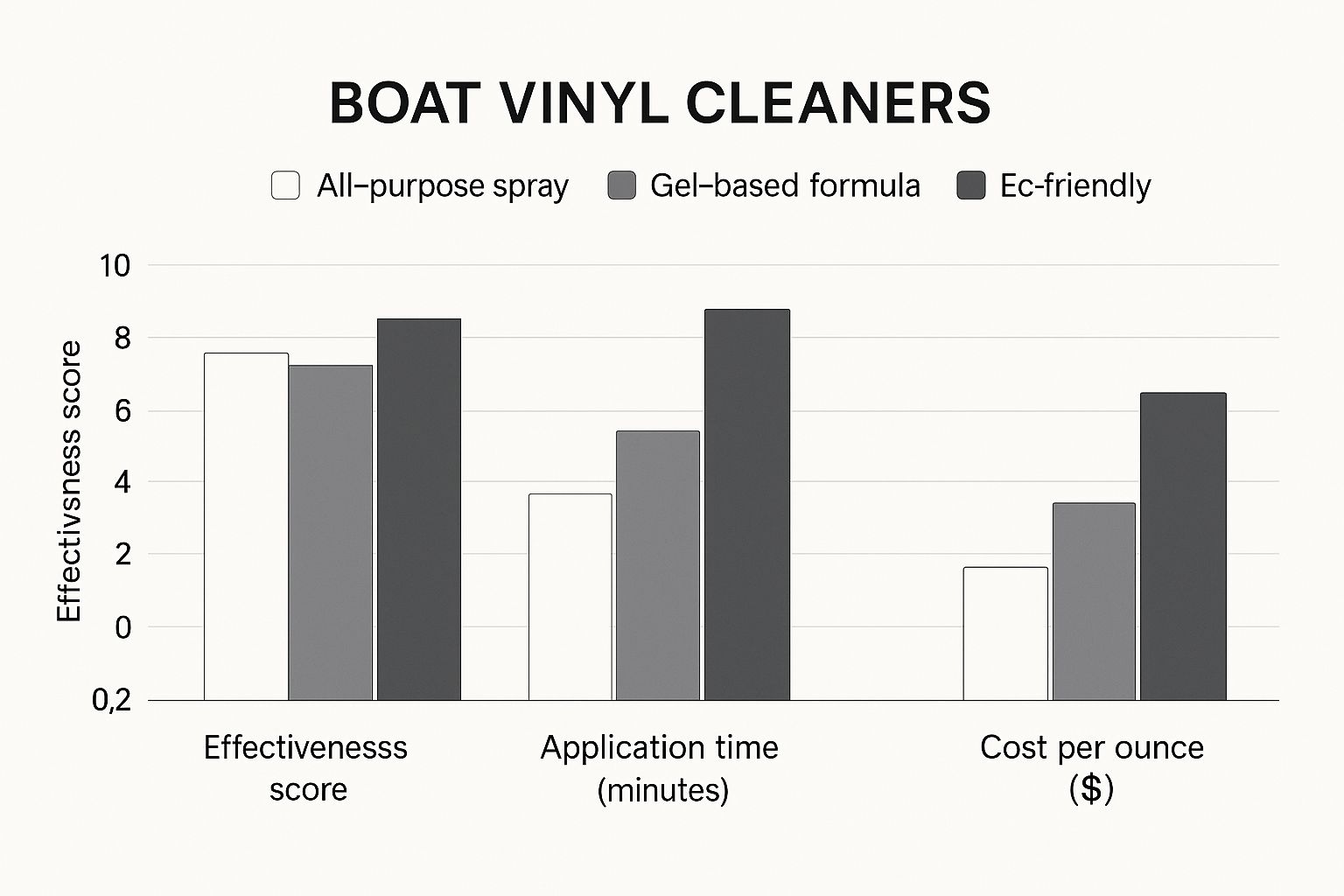
As you can see, the more powerful formulas like gels might take a bit longer to apply, but they deliver the punch you need for tough jobs. The all-purpose sprays, on the other hand, give you a great balance of speed and cleaning power for everyday messes.
Safety On Vinyl And Stitching
A powerful cleaner is useless if it destroys your upholstery in the process. How safe a formula is—especially on delicate stitching and colored vinyl—is absolutely critical.
Many aggressive cleaners use harsh chemicals that, while great on stains, can dry out the vinyl and weaken the threads holding your cushions together. Before you know it, you're looking at cracks and split seams.
- pH-Balanced Formulas: Always look for cleaners that are pH-balanced. They’re much gentler and help preserve the vinyl’s plasticizers, which is what keeps the material soft and flexible.
- Stitching-Safe Ingredients: Steer clear of products with alcohol or bleach. These are notorious for eating away at the nylon and polyester threads used in marine upholstery.
- Solvent-Free Options: Products like VinyLIFE Vinyl Cleaner & Protectant are often solvent-free. This means they can clean effectively without using chemicals that might dissolve or weaken the vinyl’s protective top layer.
Ease of Use And Application Method
Let's be honest: the best cleaner is the one you'll actually use, so convenience matters. Application methods vary a lot and really come down to your preference and cleaning style.
Spray Bottles vs. Concentrates
Spray bottles are king for convenience. You can hit a small spot or cover a whole seat in seconds. Concentrated formulas, however, are way more economical if you have a large boat or do professional detailing, but they do require you to mix them up before you can get to work.
Gel and Foam Formulas
Gel-based cleaners are brilliant for vertical surfaces because they cling without dripping all over the place. This gives the active ingredients more contact time to break down really stubborn stains. Foaming cleaners are also great for getting dirt out of textured vinyl, as the foam expands into all those tiny crevices.
A simple comparison table is a great way to see how these different products stack up at a glance. It can help guide you to the right choice based on what your boat needs and how you like to work.
Boat Vinyl Cleaner Performance Matrix
A detailed comparison of leading boat vinyl cleaners across key performance and safety metrics to help you make an informed choice.
| Product Name | Primary Use Case | Effectiveness on Mildew | UV Protection | Safe for Stitching |
|---|---|---|---|---|
| Heavy-Duty Cleaner | Deep restoration, winter storage recovery | High | Minimal to None | Variable; check label |
| All-in-One Cleaner & Protectant | Routine weekly maintenance, light stains | Medium | High | Yes |
| Eco-Friendly Solution | General cleaning, environmentally sensitive areas | Low to Medium | Low to Medium | Yes |
| Gel-Based Formula | Stubborn stains on vertical surfaces | High | None | Generally Yes |
This matrix makes it pretty clear that no single product is perfect for everything. A heavy-duty cleaner is your go-to for that once-a-season deep clean, but an all-in-one with UV protection is what you'll want for weekly maintenance to fight off sun damage. It’s all about understanding these trade-offs and picking the cleaner that fits your boat's condition and your routine.
What's Actually in Your Vinyl Cleaner? A Look at Formulations
When you're picking out a boat vinyl cleaner, you're doing more than just comparing brand names. You're choosing a chemical formula that will either protect your investment or slowly destroy it. The wrong stuff can permanently wreck your expensive upholstery, and trust me, that's a mistake you only make once.
Not all cleaners are built the same. The ingredients inside that bottle are what really determine how well it works and how safe it is for your boat's vinyl.
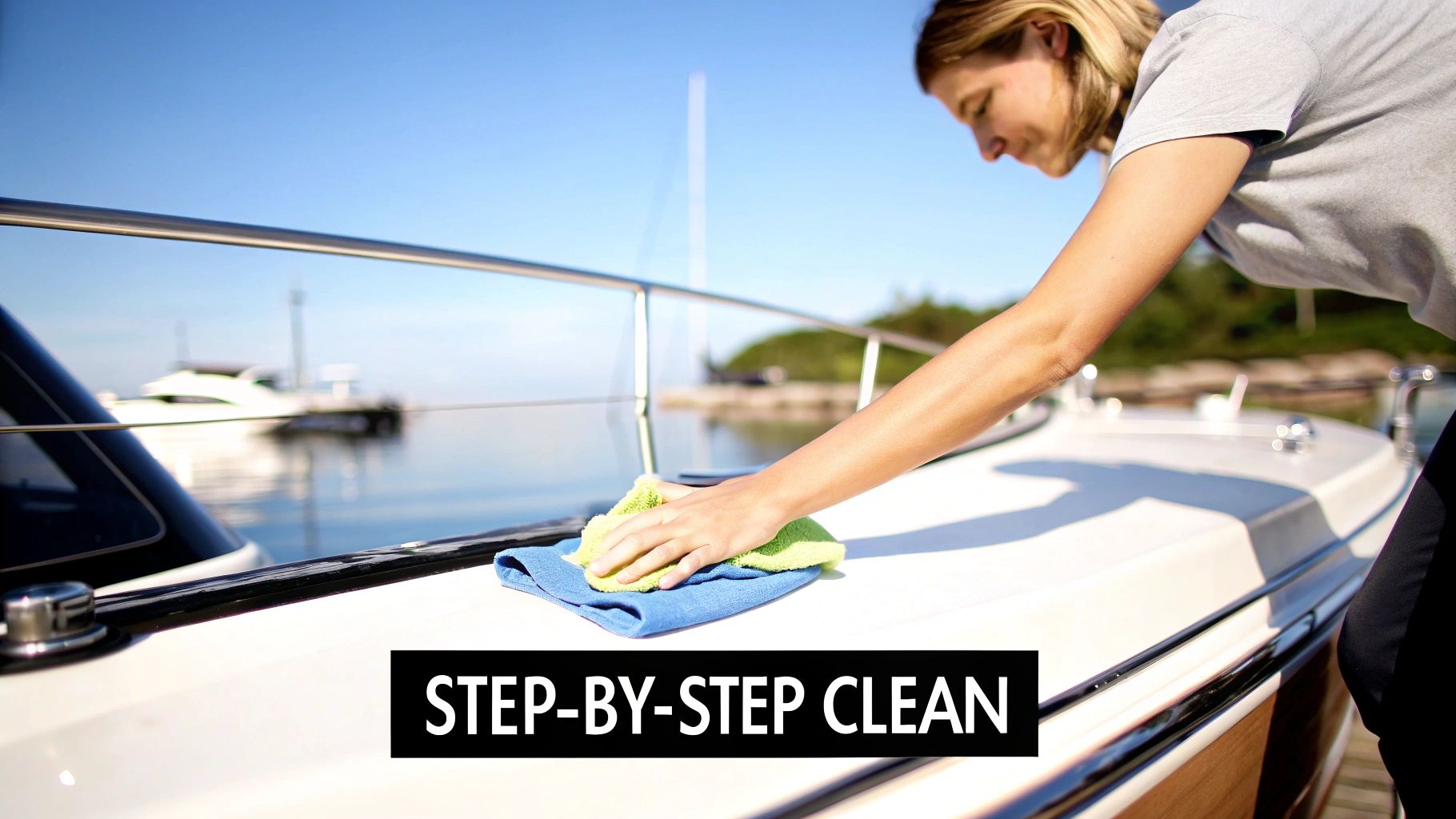
A lot of the heavy-duty cleaners get their power from harsh chemicals. While they might blast away a tough stain, they're also stripping away the plasticizers that keep your vinyl soft and pliable. That’s what leads to the cracking and premature aging that every boat owner dreads. The better, more modern formulas are typically pH-balanced, which means they clean grime without messing with the vinyl's chemical makeup.
Understanding the Good Stuff: Protective Ingredients
When you see terms like "UV protectant" or "mildewstat" on a label, pay attention. These aren't just marketing buzzwords; they're key features that will genuinely extend the life of your vinyl. Knowing what they do helps you pick a product that does more than just wipe away dirt.
- UV Protectants: Think of these as sunscreen for your boat seats. They create a barrier on the vinyl that absorbs or reflects the sun's harsh UV rays—the main culprit behind fading, yellowing, and brittleness. Using a cleaner with a UV protectant is a simple, routine way to fight sun damage.
- Mildewstats: A regular cleaner just removes the mildew you can see. A mildewstat is different; it's an agent that actively stops future mildew growth. It leaves behind an invisible shield that prevents new spores from taking hold, which is a game-changer in a damp marine environment.
If you want to get deeper into the science of how these work, you can learn more about what goes into a great marine vinyl cleaner on BetterBoat.com.
Critical Insight: The best boat vinyl cleaner isn’t just about removing dirt. It's about cleaning and protecting in one step. Formulas with integrated UV blockers and mildew inhibitors are vital for preventative maintenance, saving you from costly repairs down the line.
Harmful Ingredients to Run Away From
There are a few common cleaning agents that are an absolute disaster for marine vinyl. They might offer a quick fix for a nasty stain, but the long-term damage they cause is irreversible. Always, always check the label to make sure your cleaner doesn't contain any of these culprits.
Here are the top offenders to watch out for:
- Bleach (Sodium Hypochlorite): This is vinyl's worst enemy, hands down. It aggressively attacks the material's composition, making it brittle and prone to cracking. It also torches the color and can even eat away at the stitching holding your seats together.
- Alcohol: Isopropyl alcohol and similar solvents are great for some jobs, but not this one. They strip the vinyl of its essential oils and protective topcoat, drying it out and leaving it with a dull, sad finish that will eventually crack.
- Ammonia: You'll often find this in glass cleaners, but it has no business near your boat's upholstery. Ammonia is another harsh chemical that will dry out vinyl and cause discoloration over time.
- Abrasive Powders: Any cleaner with a gritty texture is a huge red flag. Those tiny abrasive particles will scratch and scuff the vinyl's surface, permanently dulling its finish and making it a magnet for future dirt.
How to Choose the Right Cleaner for Your Boat
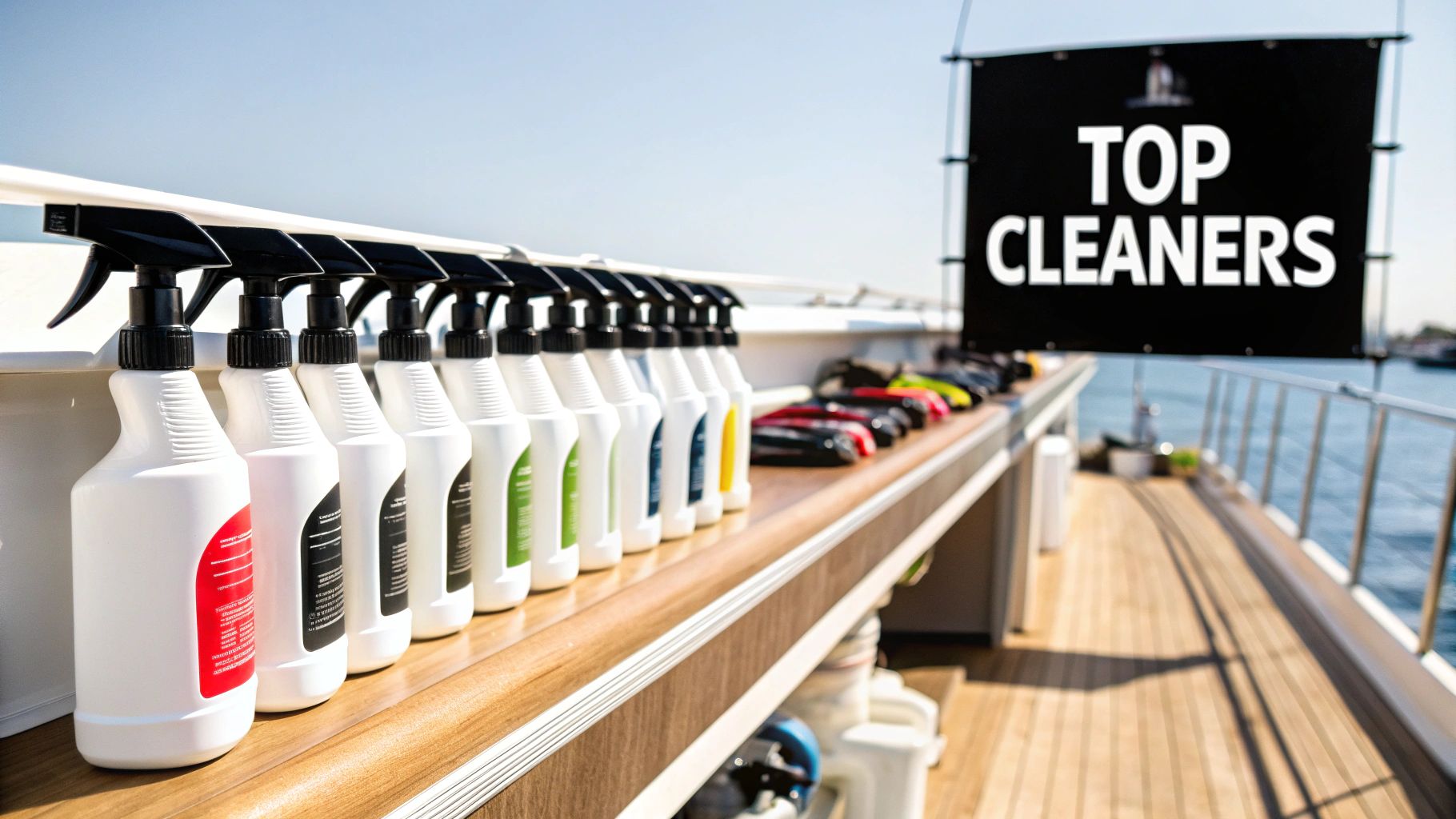
Picking the best boat vinyl cleaner isn’t about finding a single "magic bullet" product. It's really about having the right tool for the right job. The heavy-duty cleaner that obliterates deep-set mildew after a long winter in storage is almost always too harsh for a simple weekly wipe-down.
When you match the product’s strength to your actual needs, you get those perfect, clean seats without accidentally damaging your expensive upholstery. Think of it like a doctor diagnosing a problem before writing a prescription—it's a targeted strategy that will pay off big time in preserving your vinyl for years to come.
Matching Cleaner Type to Your Boating Scenario
To make it easy, let’s break down the common situations you’ll run into and point you to the right type of cleaner. This is your cheat sheet for grabbing the right bottle every single time.
Scenario 1: Routine Weekly Cleaning
For the light stuff—salt spray, fresh drink spills, and general grime after a day on the water—you want a gentle, all-purpose spray. These cleaners are made for frequent use, lifting dirt without stripping away any protective coatings. A pH-balanced formula that wipes clean without leaving a sticky film is your best friend here. Even better if you can find one with built-in UV protection.
Scenario 2: Tackling Severe Mildew After Storage
Pulling off the cover to find those ugly black or green mildew spots is a boater’s rite of passage. A standard cleaner just won't cut it. You need to bring out the big guns: a dedicated, heavy-duty mildew stain remover. These formulas are specifically engineered to kill the fungus at its source. Just be sure to follow the directions and always test it on a small, hidden spot first.
For really stubborn mildew, the best attack is a two-step process. Hit it with a dedicated mildew remover first to kill the stain. Then, follow up with a good cleaner and protectant to restore the vinyl's finish and help stop it from coming back.
Scenario 3: Maintaining Sensitive or Colored Vinyl
If you've got bright red, blue, or custom-colored vinyl, you know how vulnerable it is to fading from harsh chemicals and sun exposure. For these surfaces, you absolutely have to prioritize cleaners that are solvent-free and clearly marked as safe for all colors. Products like VinyLIFE Vinyl Cleaner & Protectant are perfect because they're gentle but still pack powerful UV blockers to keep those colors from looking washed out.
Scenario 4: The All-In-One Cleaner and Protectant
For the boater who values pure efficiency, an all-in-one product is the way to go. These are perfect if you stay on top of your maintenance and want to combine cleaning and protecting into a single step. They handle light to moderate dirt while leaving behind a protective shield that guards against sun damage and future stains, seriously streamlining your cleanup routine.
It’s no surprise that the demand for these kinds of specialized products is booming. The boat cleaner market is on track to hit $500 million by 2025, with big brands zeroing in on material-specific formulas for vinyl, hulls, and decks. You can read more about the boat cleaner market's expansion and trends to see where the industry is headed.
Your Step-By-Step Guide to Professional Vinyl Cleaning
Getting that pro-level, just-off-the-showroom-floor look on your boat's vinyl isn't about some secret sauce—it's all about the process. The right technique means you're getting every ounce of cleaning power from your product without doing any accidental damage. It really all boils down to good prep work.
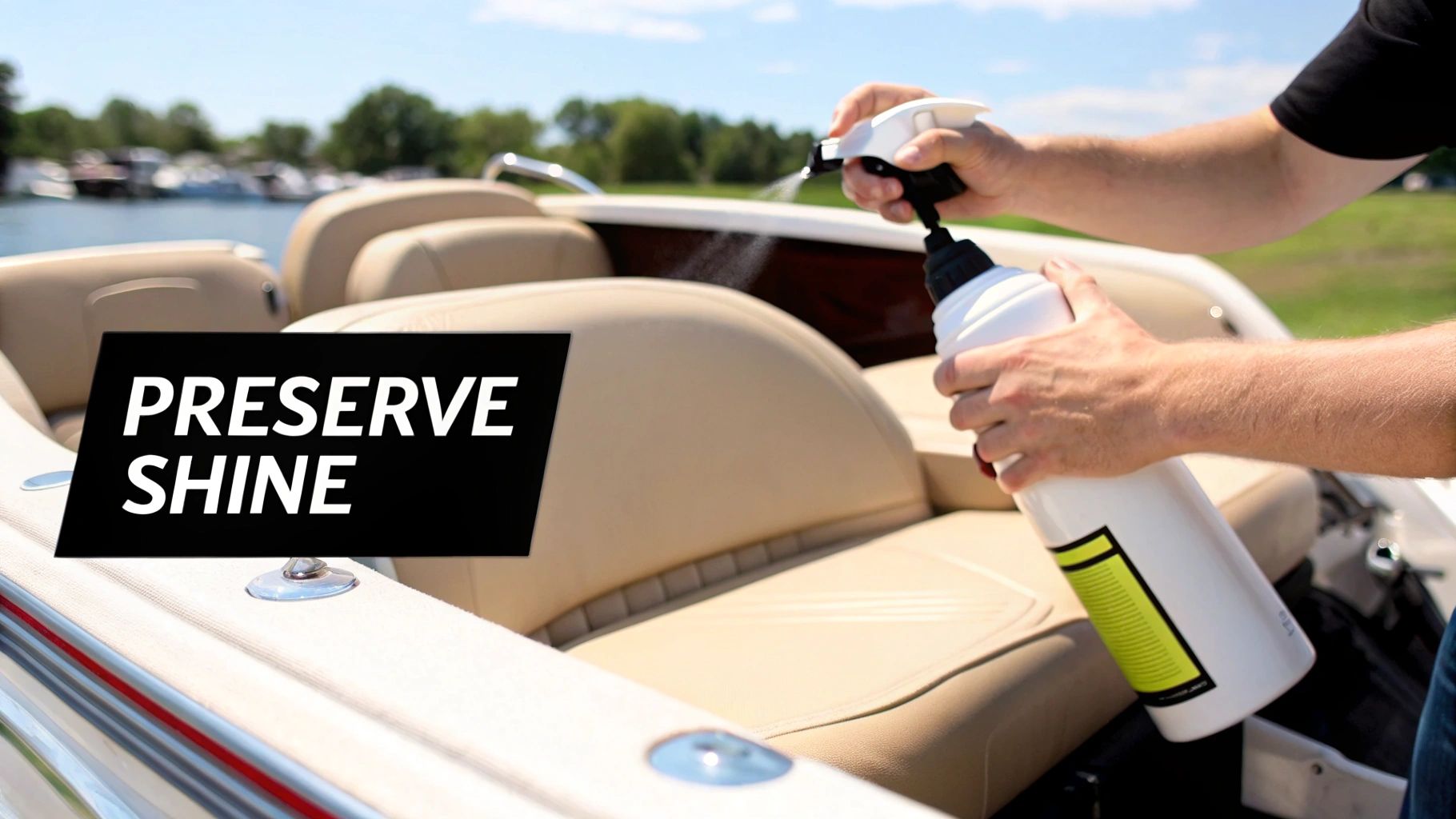
Before you even think about grabbing your cleaner, give the vinyl a quick once-over. A rinse with fresh water or a wipe with a damp cloth is all it takes. This simple first pass gets rid of loose dirt, salt, and other surface grime so you aren't grinding it into the upholstery when you start scrubbing.
Application and Agitation Techniques
Once your vinyl is prepped, it's time for the cleaner. Your method will change a bit depending on whether you're working with a spray, foam, or gel.
-
Apply the Cleaner: Spray or spread the cleaner over a small, manageable section, like a single seat cushion. Tackling one area at a time keeps the product from drying out before you've had a chance to work it in.
-
Agitate Gently: Grab the right tool for the job. A soft-bristle brush is your best friend for getting into the vinyl's texture and lifting out that deep-down grime from seams and stitching. For lighter, routine cleanups, a good microfiber towel will do the trick.
-
Let It Dwell: Let the cleaner sit for a minute or two, or whatever the label recommends. This "dwell time" is crucial. It lets the active ingredients do their thing and break down tough stains, which means a lot less elbow grease for you.
One of the biggest mistakes I see is people scrubbing way too hard, especially with a stiff brush. You can easily create tiny scratches on the vinyl's surface, which permanently dulls the finish and makes it a magnet for future stains. Let the cleaner do the heavy lifting.
Rinsing and Final Wipe-Down
Rinsing properly is a step you just can't skip. Any cleaner residue left behind can turn into a sticky film that actually attracts more dirt and can even damage the vinyl over time.
Wipe the whole area down with a clean, damp microfiber cloth to pick up every last bit of the cleaning solution. If you were dealing with a really dirty spot, you might need to rinse your cloth and go over it a second time.
Finish up by buffing the surface with a separate, dry microfiber towel. This leaves you with a clean, non-greasy finish. For a deeper dive into this entire process, check out our guide on how to clean vinyl boat seats effectively. Following these steps doesn't just make your vinyl look new again—it protects your investment for many seasons to come.
Our Top Picks for Every Boater
After putting these cleaners to the test, one thing is crystal clear: there's no single "best" boat vinyl cleaner. The right choice really depends on what you're up against. Instead of just crowning one winner, we've sorted our favorites by the real-world jobs you'll actually be doing on your boat.
This way, you’re not using a heavy-duty chemical cannon for a simple wipe-down or bringing a gentle spray to a serious mildew fight. It’s all about matching the tool to the task.
Best for Heavy-Duty Mildew Removal
For those nasty, deep-set mildew stains that greet you after a long winter in storage, you have to bring out the big guns. A dedicated mildew stain remover is non-negotiable here.
These formulas are built to do one thing and do it well: kill mold and fungus at the source. They dig deep to lift those ugly black and green stains that regular cleaners just can't handle. Think of it as the critical first step in bringing sad, neglected vinyl back to life.
Best for Routine Maintenance
For the weekly wipe-downs—getting rid of light dirt, salt spray, and fresh sunscreen smudges—an all-in-one cleaner and protectant is your best friend. These are typically pH-balanced sprays gentle enough for frequent use, so they won’t strip away the essential protectants you've already applied.
A product like VinyLIFE® Vinyl Cleaner & Protectant is a great example. It cleans and adds UV inhibitors to fend off sun damage all in one shot. It makes your regular upkeep fast and effective.
The secret to keeping your vinyl looking great for years is consistency. A good maintenance cleaner makes it easy to stay on top of the small stuff, so it never turns into a major restoration headache.
Best Eco-Friendly Option
If you're boating in environmentally sensitive waters or just prefer to use plant-based products, biodegradable cleaners are the way to go. They get the job done without harsh chemicals, keeping your upholstery and the waterways you love safe.
You might need to use a little more elbow grease on stubborn spots, but the peace of mind is worth it.
The demand for specialized marine cleaners like these is booming. The market is expected to grow to a value of around $500 million, with 10 million units sold annually by 2025. This shows just how many boaters are looking for effective, material-safe products. You can dive deeper into the trends of the expanding boat vinyl cleaner market to learn more.
Your Top Questions About Boat Vinyl Care Answered
Even with the best cleaner in your kit, taking care of your boat's vinyl can bring up a few questions. Getting it right is the key to protecting your investment and making sure your upholstery looks sharp for years to come. Here are the answers to some of the most common things we hear from fellow boaters.
How Often Should I Clean My Boat’s Vinyl Seats?
There's no single "right" answer here—it really comes down to how you use your boat. If you're out on the saltwater every weekend, you'll want to give the seats a quick wipe-down after every single trip to get that corrosive salt off. For freshwater boaters or those who only get out occasionally, a good, thorough cleaning every 2-4 weeks is a great rule of thumb.
The most important thing isn't the exact schedule, but staying consistent. A quick, routine cleaning is always going to be easier than letting dirt and grime bake in, turning a small task into a huge restoration project down the line.
Can I Use Household Cleaners on Boat Vinyl?
Reaching for household products like bleach or a magic eraser is one of the quickest ways to absolutely ruin your marine vinyl. These cleaners are simply too aggressive for boat upholstery and will cause permanent damage.
- Bleach is a disaster for vinyl. It will strip out the color, chemically break down the material, and leave it brittle and ready to crack.
- Abrasive sponges act like fine-grit sandpaper, creating thousands of tiny scratches. This dulls the finish instantly and gives dirt and mildew a perfect place to grab onto next time.
Always, always stick to a cleaner that's actually made for marine vinyl. A household product might seem like a cheap and easy fix in the moment, but the cost of reupholstering your boat is way higher than just buying the right cleaner to begin with.
What Is the Best Way to Prevent Mildew from Returning?
Getting rid of mildew is only half the battle. Making sure it doesn't come right back is the real win. To do that, you have to make your boat an unfriendly place for it to grow.
Start by getting some air moving, especially when the boat is covered or put away for storage. Tossing in a few moisture-absorbing products can also make a huge difference in cutting down the dampness that mildew needs to survive.
Most importantly, always follow up your cleaning with a product that has a mildew inhibitor or a dedicated vinyl protectant spray. This creates an invisible shield that stops new spores from settling in, keeping your seats looking clean and fresh for much longer.
For a complete line of cleaning and care products designed to protect your investment, trust Better Boat. Explore our full range of solutions and find everything you need at https://www.betterboat.com.


